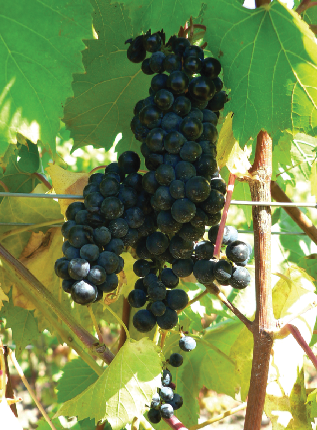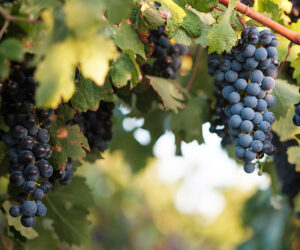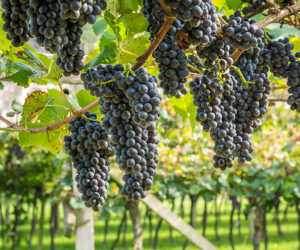
Marechal Foch, named after a famous French general in the First World War, has proven to be a worthwhile red grape variety for many colder regions of the world. Technically identified as the Kuhlmann 188, the variety was developed in France during the latter part of the twentieth century by an Alsatian named Hans Kuhlmann.
Kuhlmann crossed a riparia–rupestris hybrid and the vinifera variety Goldriesling — Riesling x Courtiller Musque, which was an early-maturing Muscat — and the Marechal Foch was created. At the time, Marechal Foch was planted on phylloxera-free rootstock in regions that experienced cold winter weather. The variety became a prolific producer and continues with that reputation today. Likened by many to the primary Burgundian red grape (Pinot Noir), Marechal Foch enjoys many positive attributes.
Marechal Foch can withstand freezing temperatures, below 32° F (0° C), for extended periods of time. Several amateur growers told me that they thought Marechal Foch could grow in Alaska, which might be an exaggeration, but the point was made. The variety was planted extensively in France during the latter part of the 1800s right through the latter part of the twentieth century, until the French government mandated that hybrid, non-noble varieties be removed.
Ideal Growing Regions for Marechal Foch
The Eastern parts of the United States and Canada are ideal locations for the planting of Marechal Foch. New York State has extensive acreage dedicated to Marechal Foch and the variety continues to produce quality fruit there. The variety is also planted in most northeastern states, western states and Canada with positive results.
Although Marechal Foch can and does withstand coldness, it is vulnerable to mildew in some areas and requires preventative spraying — with a chemical called Benomyl — to solve that potential problem.
The variety ripens early, and is usually ready for picking between 80 and 90 days after budbreak. This is a very positive feature in cold climates, but the variety doesn’t always develop enough sugar content. Brix counts in most cold areas where Marechal Foch is planted have percentages in the 15 to 18 percent range. This forces winemakers to chaptalize (add sugar before fermentation) to bring the counts up to the necessary 20 to 23 percent range. This also happens when the grapes are picked early.
On the other hand, acid numbers are usually excessively high when picked early and often measure beyond 1.0 percent. We prefer the acid count to be in the 0.6 to 0.9 percent range. The acid count should be brought down by adding a sugar and water mixture. The water dilutes the acid while the sugar ensures that the Brix count remains the same. Two pounds (0.9 kg) of granulated sugar is dissolved in three quarts (2.9 L) of warm water. Add small amounts of this mix to the must and re-measure the acid count. Repeat until the acid count has fallen to an acceptable level.
Picking Strategies for Marechal Foch
Picking early is a practical option for most northern-tier grape growers, as many predators tend to invade the vineyard and gobble up the fruit when the berries are ripe or nearing ripeness. The threat of an incoming frost, which could damage the crop, is another incentive for early picking.
The other option is to leave the grapes on the vine longer in hopes that the usually warm, pleasant, fall weather will help to elevate sugar counts and decrease acid counts. That’s the way Mother Nature works — when sugar counts rise, acid counts fall. High sugar and low acid counts minimize the potential pre-fermentation adjustments by the winemaker.
In order to deter predators, the use of plastic netting has proven to be a successful practice for home vineyard owners. When the vines are nearing maturity, plastic netting is placed over the vines and anchored to the ground on both sides of the vines. This creates a defensive barrier against birds, deer and other grape thieves. This practice has proven successful but the initial cost is a consideration. The bird netting can be used for years on end if it is tended to properly.
Home Winemakers and Marechal Foch
Charles Stephenson is a practicing architect from Simsbury, Connecticut and a long-time grape grower and amateur home winemaker. Stephenson grows Marechal Foch and Leon Millot — Kuhlmann 194.2, a close cousin of Marechal Foch — in a neat, precise, small vineyard. The site is cold, with sustained periods below freezing. Other varieties have not survived the often-harsh winters but the Marechal Foch and Leon Millot are doing well and have been productive.
Stephenson likes the tight, close clusters of the grapes, which produce about two tons per acre for him, and he allows the grapes to stay on the vine beyond the early stages of maturity. He also has to net the grapes to preserve them during this critical period of development. He picks his Marechal Foch when the sugar count gets to 20 percent. At that time the acid is usually around 0.9, which he says he can live with. He ferments Marechal Foch in glass and steel and adds wood chips for additional flavoring. He uses the Lalvin 71B-1122 commercial yeast strain because it eats up some of the malic acid during the fermentation process, which helps soften the wine.
He likens his wine to a Burgundian “Vin d’Pays,” or everyday Burgundy drinking wine. But Stephenson is quick to point out that any red hybrid will never have the same qualities of a red vinifera. However, when the options are limited due to climate, Marechal Foch or Leon Millot are reasonable choices. He has no intention of expanding his vineyard with any more red-hybrid types but is considering a couple of vinifera whites and hybrid whites for future expansion. On occasion, Stephenson has made a blush or pink wine from some of his Marechal Foch, but generally he is straightforward about his style of making his Marechal Foch á la Burgundy.
Commercial Wineries and Marechal Foch
Jim Jerram of New Hartford has two acres of twenty-year-old Marechal Foch vines on his six-acre farm winery in this cold-climate community in northern Connecticut. Once an amateur home winemaker, Jerram started a farm winery a few years ago that features his Marechal Foch, which he loves. He reports that the grape does well in his area but does require some irrigation and attention to mildew. He produces about two and a half tons per acre and he makes two different styles of red table wine. He ferments 80 percent of the must in stainless steel and 20 percent in glass. He then ages about 50 percent of the new wine in wood and the balance in steel. The use of different fermenters adds to the complexity of the wine. The wood fermenter offers vanilla and buttery traits while the glass fermenter helps retain the fruitiness of the wine. He picks his grapes early, at about 17 percent sugar and 1.1 percent acid, then makes adjustments before fermenting. Jerram uses the Lalvin Bourgovin (RC212) yeast and lets his wine go through a malolactic fermentation.
Jerram’s first wine is a blend of Marechal Foch and Cabernet Franc. The percentages of each variety will change from year to year depending upon each wine’s character and the availability of each variety. The second wine is 100 percent Marechal Foch and develops a port-like and sherry-like bouquet over time. Jerram says that this wine is woody and very complex, and people either love it or hate it. Most people seem to love it, since it sells out every year.
Jerram hasn’t changed his style of making Marechal Foch for twenty years — and he says he has no intention of changing now, as long as he keeps selling everything he is making. Jerram also says that he is increasing his vineyard capacity by approximately half an acre per year and that Marechal Foch planting will continue to be a major portion of his ever-expanding vineyard.
Personal Experience with Marechal Foch
My first encounter with Marechal Foch was about twenty years ago, when I received 300 pounds (136 kg) of fresh Marechal Foch grapes in lieu of a debt that couldn’t be fulfilled with cash, which was my first choice. I thought that I might make a blush wine with my Marechal Foch. Little did I realize that Foch’s deep, inky-colored juice could never be made into a blush wine unless you added a lot of white wine to it. When I pulled my hand out of the must it looked like a blue glove. I had to wear this blue glove for several days, as I was unable to get the dark red stain out of my skin. I quickly learned that Marechal Foch is a very dark-colored, heavy-bodied red wine — a variety that can do wonders for light-colored, light-bodied red wines as a blending partner.
Through the years I have made dozens of Marechal Foch vintages, but always felt that the wine was best when it was blended and oaked. My personal preference for red wines is vinifera-type grapes, but if I had no other options I could survive on Marechal Foch.
Recommended Yeast Strains
Both amateur and commercial winemakers came up with three yeast strain choices for making Marechal Foch wine. Wyeast Assmannhausen is a red-wine yeast from Germany that ferments slowly and enhances the varietal character in French-American hybrids. The Lalvin 71B-1122 produces fruity wines and metabolizes more malic acid during fermentation than other strains. The Lalvin Bourgovin (RC-212) is a low-foaming, moderate-speed fermenter with good alcohol tolerance and maximum extraction in reds. If the above yeast strains are not available, try the Red Star Premier Cuvée (formerly known as Prise de Mousse). This yeast strain is good for both sparkling and still wines, red and whites, and good for restarting a stuck fermentation.
The reports we received from our research of Marechal Foch grape growers and winemakers was consistent when addressing the lack of “foxiness” or “grapey taste” that the variety exhibits, unlike its native American counterparts. As a rule, most red hybrids have eliminated these unfavorable aromas and flavors.







